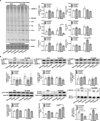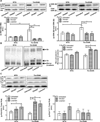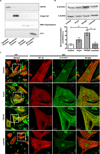Long-Term Biased β-Arrestin Signaling Improves Cardiac Structure and Function in Dilated Cardiomyopathy
- PMID: 28104714
- PMCID: PMC5350031
- DOI: 10.1161/CIRCULATIONAHA.116.024482
Long-Term Biased β-Arrestin Signaling Improves Cardiac Structure and Function in Dilated Cardiomyopathy
Abstract
Background: Biased agonism of the angiotensin II receptor is known to promote cardiac contractility. Our laboratory indicated that these effects may be attributable to changes at the level of the myofilaments. However, these signaling mechanisms remain unknown. Because a common finding in dilated cardiomyopathy is a reduction in the myofilament-Ca2+ response, we hypothesized that β-arrestin signaling would increase myofilament-Ca2+ responsiveness in a model of familial dilated cardiomyopathy and improve cardiac function and morphology.
Methods: We treated a dilated cardiomyopathy-linked mouse model expressing a mutant tropomyosin (Tm-E54K) for 3 months with either TRV120067, a β-arrestin 2-biased ligand of the angiotensin II receptor, or losartan, an angiotensin II receptor blocker. At the end of the treatment protocol, we assessed cardiac function using echocardiography, the myofilament-Ca2+ response of detergent-extracted fiber bundles, and used proteomic approaches to understand changes in posttranslational modifications of proteins that may explain functional changes. We also assessed signaling pathways altered in vivo and by using isolated myocytes.
Results: TRV120067- treated Tm-E54K mice showed improved cardiac structure and function, whereas losartan-treated mice had no improvement. Myofilaments of TRV120067-treated Tm-E54K mice had significantly improved myofilament-Ca2+ responsiveness, which was depressed in untreated Tm-E54K mice. We attributed these changes to increased MLC2v and MYPT1/2 phosphorylation seen only in TRV120067-treated mice. We found that the functional changes were attributable to an activation of ERK1/2-RSK3 signaling, mediated through β-arrestin, which may have a novel role in increasing MLC2v phosphorylation through a previously unrecognized interaction of β-arrestin localized to the sarcomere.
Conclusions: Long-term β-arrestin 2-biased agonism of the angiotensin II receptor may be a viable approach to the treatment of dilated cardiomyopathy by not only preventing maladaptive signaling, but also improving cardiac function by altering the myofilament-Ca2+ response via β-arrestin signaling pathways.
Keywords: TRV120027; TRV120067; biased ligand; calcium sensitivity; sarcomeres.
© 2017 American Heart Association, Inc.
Figures







Comment in
-
Biased Agonism at the Angiotensin Receptor: Blocker and Calcium Sensitizer at the Same Time.Circulation. 2017 Mar 14;135(11):1071-1074. doi: 10.1161/CIRCULATIONAHA.117.027276. Circulation. 2017. PMID: 28289006 No abstract available.
References
-
- Yancy CW, Jessup M, Bozkurt B, Butler J, Casey DE, Drazner MH, Fonarow GC, Geraci SA, Horwich T, Januzzi JL, Johnson MR, Kasper EK, Levy WC, Masoudi FA, McBride PE, McMurray JJV, Mitchell JE, Peterson PN, Riegel B, Sam F, Stevenson LW, Tang WHW, Tsai EJ, Wilkoff BL. 2013 ACCF/AHA Guideline for the Management of Heart Failure: A Report of the American College of Cardiology Foundation/American Heart Association Task Force on Practice Guidelines. Circulation. 2013;128:e240–e327. - PubMed
-
- Correll CC, McKittrick BA. Biased Ligand Modulation of Seven Transmembrane Receptors (7TMRs): Functional Implications for Drug Discovery. J Med Chem. 2014;57:6887–6896. - PubMed
MeSH terms
Substances
Grants and funding
LinkOut - more resources
Full Text Sources
Other Literature Sources
Molecular Biology Databases
Miscellaneous

